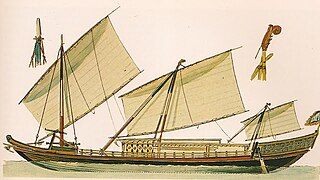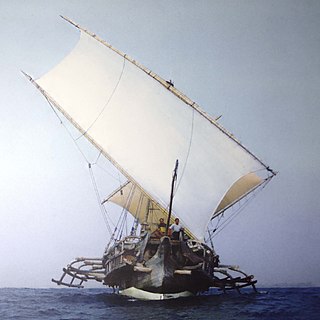
Majapahit, also known as Wilwatikta, was a Javanese Hindu-Buddhist thalassocratic empire in Southeast Asia that was based on the island of Java. It existed from 1293 to circa 1527 and reached its peak of glory during the era of Hayam Wuruk, whose reign from 1350 to 1389 was marked by conquests that extended throughout Southeast Asia. His achievement is also credited to his prime minister, Gajah Mada. According to the Nagarakretagama written in 1365, Majapahit was an empire of 98 tributaries, stretching from Sumatra to New Guinea; consisting of present-day Indonesia, Singapore, Malaysia, Brunei, southern Thailand, Timor Leste, southwestern Philippines although the scope of Majapahit sphere of influence is still the subject of debate among historians. The nature of Majapahit relations and influences upon its overseas vassals and also its status as an empire still provokes discussion.

Borobudur, also transcribed Barabudur is a 9th-century Mahayana Buddhist temple in Magelang Regency, not far from the city of Magelang and the town of Muntilan, in Central Java, Indonesia.

The Javanese are an Austronesian ethnic group native to the central and eastern part of the Indonesian island of Java. With more than 100 million people, Javanese people are the largest ethnic group in both Indonesia and in Southeast Asia as a whole. Their native language is Javanese, it is the largest of the Austronesian languages in number of native speakers and also the largest regional language in Southeast Asia. The Javanese as the largest ethnic group in the region have dominated the historical, social, and political landscape in the past as well as in modern Indonesia and Southeast Asia.

Nusantara is the Indonesian name of Maritime Southeast Asia. It is an Old Javanese term that literally means "outer islands". In Indonesia, it is generally taken to mean the Indonesian Archipelago. Outside of Indonesia, the term has been adopted to refer the Malay Archipelago.

The Mataram Kingdom ; also known as Medang Kingdom was a Javanese Hindu–Buddhist kingdom that flourished between the 8th and 11th centuries. It was based in Central Java, and later in East Java. Established by King Sanjaya, the kingdom was ruled by the Shailendra dynasty and Ishana dynasty.
Urduja was a legendary warrior princess recorded in the travel accounts of Ibn Battuta. She was described to be a princess of Kaylukari in the land of Tawalisi. Though the locations of Kaylukari and Tawalisi are disputed, in the Philippines, Urduja is believed by modern Filipinos to be from Pangasinan, and has since been regarded as a national heroine.

A candi is a Hindu or Buddhist temple in Indonesia, mostly built during the Zaman Hindu-Buddha or "Hindu-Buddhist period" between circa the 4th and 15th centuries.
Indonesian Esoteric Buddhism or Esoteric Buddhism in Maritime Southeast Asia refers to the traditions of Esoteric Buddhism found in Maritime Southeast Asia which emerged in the 7th century along the maritime trade routes and port cities of the Indonesian islands of Java and Sumatra as well as in Malaysia. These esoteric forms were spread by pilgrims and Tantric masters who received royal patronage from royal dynasties like the Sailendras and the Srivijaya. This tradition was also linked by the maritime trade routes with Indian Vajrayana, Tantric Buddhism in Sinhala, Cham and Khmer lands and in China and Japan, to the extent that it is hard to separate them completely and it is better to speak of a complex of "Esoteric Buddhism of Mediaeval Maritime Asia." Many key Indian port cities saw the growth of Esoteric Buddhism, a tradition which coexisted alongside Shaivism.

Penataran or Panataran is one of the largest Hindu temple ruins complexes in East Java, Indonesia. It is located in Penataran, Blitar Regency, roughly 12 km northeast of Blitar, with the closest airport being farther away at Malang. Believed to have been constructed between the 12th century to the 15th century, the temple played a significant role in the Majapahit Kingdom, especially under King Hayam Wuruk. He considered it his favorite sanctuary. Penataran dates from the Kediri era.

Samudra Raksa Museum is a maritime museum that was built several hundred meters north of the 8th-century Borobudur Buddhist monument, within the Borobudur archaeological complex, Magelang, Central Java, Indonesia. The museum features and interprets the ancient maritime Indian Ocean trade among between ancient Indonesia, Madagascar, and East Africa, popularly dubbed as "the cinnamon route". The centerpiece of museum is the full-scale reconstruction of the 8th-century Borobudur ship. It was used in a successful expedition from Indonesia to Madagascar and Ghana in 2003—2004. The Borobudur Ship — a 25 meter-long wooden ship modeled after wall reliefs found on the 8th century Borobudur temple in Central Java.
K'un-lun po were ancient sailing ships used by Austronesian sailors from Maritime Southeast Asia, described by Chinese records from the Han Dynasty. In the first millennium AD, these ships connected trade routes between India and China. Ships of this type were still in use until at least the 14th century.

Indonesia–Madagascar relations spans for over a millennium, since the ancestors of the people of Madagascar sailed across the Indian Ocean from the Nusantara Archipelago back in 8th or 9th century AD. Indonesia has an embassy in Antananarivo, while Madagascar does not have an accreditation to Indonesia. It was announced in December 2017 that Madagascar would be opening an embassy in Jakarta in 2018, however, the embassy was never opened.

Phillip Beale is a British sailor, adventurer, expedition leader and entrepreneur. He led the Borobudur Ship Expedition and the 2008–2010 Phoenician Expedition.

It is quite difficult to define Indonesian art, since the country is immensely diverse. The sprawling archipelago nation consists of 17.000 islands. Around 922 of those permanently inhabited, by over 1,300 ethnic groups, which speak more than 700 living languages.

A lancaran or lanchara is a type of sailing ship used in Maritime Southeast Asia. Although similar in shape to Mediterranean galleys, the lancaran was the backbone of the regional fleet of the western half of Nusantara before Mediterranean influence came. For their war fleet, the Malays prefer to use shallow draught, oared longships similar to the galley, such as lancaran, penjajap, and kelulus. This is very different from the Javanese who prefer long-range, deep-draught round ships such as jong and malangbang. The reason for this difference is that the Malays operated their ships in riverine water, sheltered straits zone, and archipelagic environment, while the Javanese are often active in the open and high sea. After contact with Iberian people, both the Javanese and Malay fleets began to use the ghurab and ghali more frequently.

The djong, jong, or jung is a type of sailing ship originating from Java, Indonesia that was widely used by Javanese, Sundanese, and later, also by Peguan and Malay sailors. The word was and is spelled jong in its languages of origin, the "djong" spelling being the colonial Dutch romanization. In English, the djong lends its name to other ships of similar configuration, called junks, and to their characteristic style of rigging, the junk rig.

Tanja sail or tanja rig is a type of sail commonly used by the Austronesian people, particularly in Maritime Southeast Asia. It is also known as the tilted square sail, canted rectangular sail, rectangular balance lug, or balance lug sail in English. In historical sources, tanja sail is sometimes incorrectly referred to as lateen sail or simply square sail.

Ghurab or gurab is a type of merchant and warship from the Nusantara archipelago. The ship was a result of Mediterranean influences in the region, particularly introduced by the Arabs, Persians, and Ottomans. For their war fleet, the Malays prefer to use shallow draught, oared longships similar to the galley, such as lancaran, penjajap, and kelulus. This is very different from the Javanese who prefer long-range, deep-draught round ships such as jong and malangbang. The reason for this difference is that the Malays operated their ships in riverine water, sheltered straits zone, and archipelagic environment, while the Javanese are often active in the open and high sea. After contact with Iberian people, both the Javanese and Malay fleets began to use the ghurab and ghali more frequently.

Samudra Raksa is a replica ship built in 2003 based on the relief of ships in the Borobudur temple. In the late 20th century, Philip Beale, a British sailor, became interested in depictions of the ship at Borobudur and decided to reconstruct one. Aided by government and international bodies, he organized an expedition team that constructed the ship and, from 2003 to 2004, sailed it from Indonesia to Madagascar and to Ghana, proving that long-distance trade could have occurred. The Samudra Raksa Museum was constructed at Borobudur Archeological Park to house the ship, opening in 2005, and provides other displays to interpret the ancient maritime history of Indonesians.


























